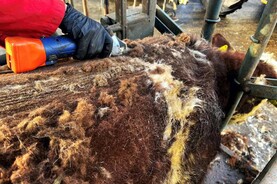Grass growth is in full swing around the country and next winter’s silage supplies are making their way to yards and silage pits now.
We are also in the middle of the busy breeding season on many suckler farms.
The tough spring of 2024 has taken its toll on some farms, with cows a little slower to come back into heat as a result of losing condition a few months ago when forage supplies were tight.
We take a look at the options for late-calving cows on suckler farms.
It’s a difficult one, especially where cows are late through no fault of their own where fodder ran out but decisions will need to be made on what to do. Do you stick with them and try to pull them back?
Our experience on Tullamore Farm with late-calving cows has been that it’s very difficult to ever get these cows back to where you want them to be in terms of earlier calving and, in many situations, you are probably better to bite the bullet, cull the late-calving cow and try to bring in an earlier calving heifer in her place.
Aidan Brennan takes a look at summer dosing of dairy calves. The gold standard here is to faecal sample calves before dosing to determine if there are worms present.
Anthelmintic resistance is an issue on some farms and we must all do our bit to avoid it becoming a bigger problem in the industry.
Cavan vet Finbarr Kiernan has an interesting take on the rise of redwater cases in the northwest and the possible reason for the spike in cases.
We also take a look at mastitis prevention and treatment on suckler farms, a problem that comes up every year.
Martin Merrick takes a look at what to remember when it comes to sheep health this summer.
Grass growth is in full swing around the country and next winter’s silage supplies are making their way to yards and silage pits now.
We are also in the middle of the busy breeding season on many suckler farms.
The tough spring of 2024 has taken its toll on some farms, with cows a little slower to come back into heat as a result of losing condition a few months ago when forage supplies were tight.
We take a look at the options for late-calving cows on suckler farms.
It’s a difficult one, especially where cows are late through no fault of their own where fodder ran out but decisions will need to be made on what to do. Do you stick with them and try to pull them back?
Our experience on Tullamore Farm with late-calving cows has been that it’s very difficult to ever get these cows back to where you want them to be in terms of earlier calving and, in many situations, you are probably better to bite the bullet, cull the late-calving cow and try to bring in an earlier calving heifer in her place.
Aidan Brennan takes a look at summer dosing of dairy calves. The gold standard here is to faecal sample calves before dosing to determine if there are worms present.
Anthelmintic resistance is an issue on some farms and we must all do our bit to avoid it becoming a bigger problem in the industry.
Cavan vet Finbarr Kiernan has an interesting take on the rise of redwater cases in the northwest and the possible reason for the spike in cases.
We also take a look at mastitis prevention and treatment on suckler farms, a problem that comes up every year.
Martin Merrick takes a look at what to remember when it comes to sheep health this summer.






 This is a subscriber-only article
This is a subscriber-only article










SHARING OPTIONS: